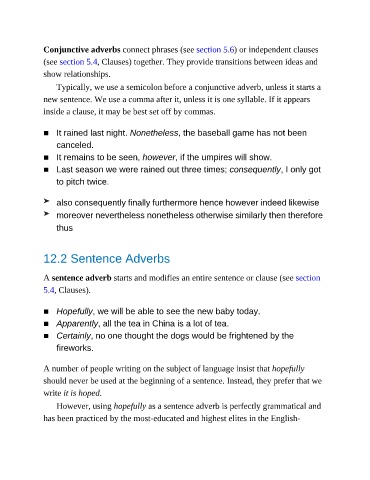Page 142 - Perfect English Grammar: The Indispensable Guide to Excellent Writing and Speaking
P. 142
Conjunctive adverbs connect phrases (see section 5.6) or independent clauses
(see section 5.4, Clauses) together. They provide transitions between ideas and
show relationships.
Typically, we use a semicolon before a conjunctive adverb, unless it starts a
new sentence. We use a comma after it, unless it is one syllable. If it appears
inside a clause, it may be best set off by commas.
■ It rained last night. Nonetheless, the baseball game has not been
canceled.
■ It remains to be seen, however, if the umpires will show.
■ Last season we were rained out three times; consequently, I only got
to pitch twice.
also consequently finally furthermore hence however indeed likewise
moreover nevertheless nonetheless otherwise similarly then therefore
thus
12.2 Sentence Adverbs
A sentence adverb starts and modifies an entire sentence or clause (see section
5.4, Clauses).
■ Hopefully, we will be able to see the new baby today.
■ Apparently, all the tea in China is a lot of tea.
■ Certainly, no one thought the dogs would be frightened by the
fireworks.
A number of people writing on the subject of language insist that hopefully
should never be used at the beginning of a sentence. Instead, they prefer that we
write it is hoped.
However, using hopefully as a sentence adverb is perfectly grammatical and
has been practiced by the most-educated and highest elites in the English-

